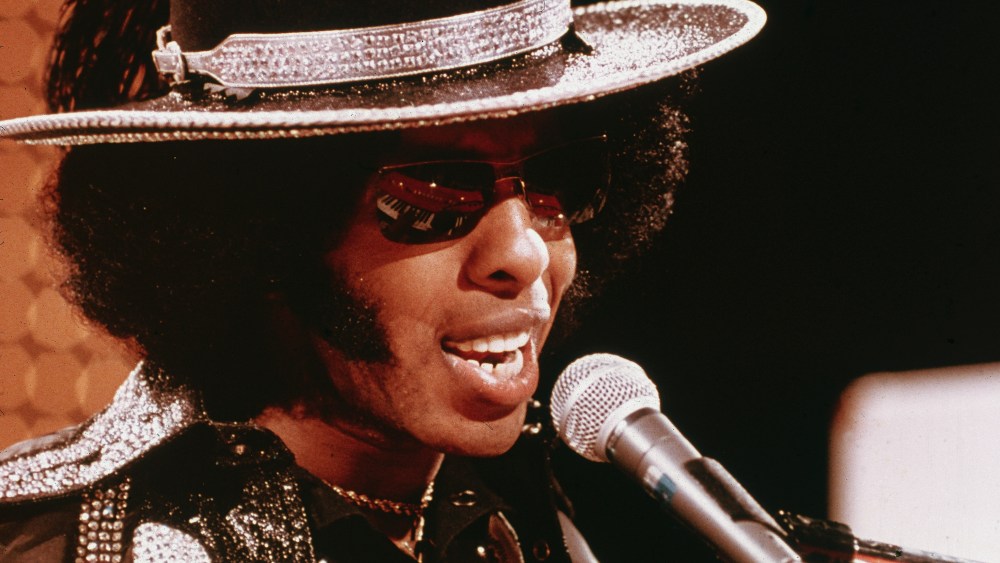Sylvester Stewart — known to most of the world as Sly Stone, who passed away at 82 on Monday — was one of the most important musicians not only of the rock-soul era — because his music combined both, and lots more — but of the 20th century. No less an icon than Miles Davis rated three musicians from the 1960s: James Brown, Jimi Hendrix, and Sly, and their work deeply influenced his.
Sly Stone wasn’t only among the first songwriter-musician-producers to create pop music that combined so many genres, and a band that mixed genders and races, so fluidly: He was also a world-class performer, an innovative lyricist, a godfather of hip-hop (and one of the most sampled artists in history), one of the first major musicians to play every instrument himself on many songs, and, before he descended into substance abuse, a symbol of positivity.
It’s there in the lyrics: “Everybody Is a Star.” “You Can Make It If You Try.” “I am no better and neither are you/ We are the same, whatever we do/ You love me, you hate me, you know me and then/ You can’t figure out the bag I’m in” (from “Everyday People”). “Stand for the things you know are right/ It’s the truth that the truth makes them so uptight/ Stand, all the things you want are real/ You have you to complete and there is no deal.” (“Stand!”) Those messages, coming at a time of deep division and unrest in the country, featured themes of equality and self-belief, but also defiance — and they turned much darker as the ‘70s began and he released the ominous “There’s a Riot Goin’ on” album, which offered a much more negative take on the era.
Sly’s versatility came from a combination of natural talent, being raised as a church musician with his family, working as a radio DJ in San Francisco, and then as a producer — all before he formed the Family Stone, and all before he was 25. His discography, which sadly ends in 1980s, rewards hours of deep diving, as Questlove’s definitive documentary, “Sly Lives!,” from earlier this year shows; also highly recommended is the compilation “I’m Just Like You: Sly’s Stone Flower 1969-70,” which features his production work for artists signed to his short-lived Stone Flower label, but acts as a musical bridge between “Stand!” and “There’s a Riot Goin’ on.”
The essential songs that may be obvious — nearly all are from 1969, and many come from the stellar 1970 “Greatest Hits” album — but they’re the ones he’ll be most remembered for.
“Dance to the Music” (1968) — After the Family Stone’s debut album flopped, Sly was often told his music was too complex, so he stripped his songwriting down to the bone. This song is basically just a chorus and a band introduction, but the delivery and irresistibility music say much more than the lyrics — and nobody could tell him it was too complicated.
“Sing a Simple Song” (1969) — With its unforgettable “Hey-hey-hey-hey” hook and innovative rhythms (driven by the group’s stellar drummer, Greg Errico), this was Sly’s next iteration of not letting things get too complex — the message is in the title, but try getting the breakdown in the middle out of your head.
“Stand!” (1969) — The title track of the group’s most popular (and arguably its best) album, “Stand!” exemplifies the positivity, self-belief and resilience that Sly and the band’s music from the era defined. Its lilting melody leads the listener by the band straight into the fist-pumping chorus, which simply repeats the title multiple times — with the exclamation mark included.
“Hot Fun in the Summertime” (1969) — One of Sly’s greatest melodies, this remarkably brief but fully realized song was released in July of 1969, the summer of Woodstock and also the “Summer of Soul,” the Harlem festival immortalized in Questlove’s Oscar-winning documentary and in which the group performed. It’s also one of the most summer-sounding songs of the century, with a pumping rhythm and a sunny “Hi, hi-hi-hi there” refrain tailor-made for singing out of a car window.
“Everyday People” (1968) — If it possible to have a playful take on the absurdity of racism, it’s “Everyday People”: “There is a blue one who can’t accept the green one/ For living with a fat one, trying to be a skinny one/ Different strokes for different folks/ And so on and so on and scooby-dooby-dooby” — at its base, racism is so ridiculous that the verses can only end with nonsense, which is then crushed with Sly’s exuberant chorus, “I’m everyday people!”
“(I Want to Take You) Higher” (1969) — The ultimate version of this song, of course, is the electrifying version that shook both Woodstock and the Woodstock generation. Quite possibly the highlight of that entire legendary festival, the performance and its presence in the 1970 film lofted Sly and the Family Stone into one of the most popular music acts in the world. Sadly, it was all downhill from there, but there were many highlights to come in the next few years.
“Everybody Is a Star” (1969) — A kind of farewell to Sly’s era of positivity, it’s hard to imagine a stronger send-off, with its deeply soulful vocals and heartfelt melody and message: “Everybody is a star/ Who would rain and chase the dust away/ Everybody wants to shine/ Who’ll come out on a cloudy day… When the system tries to bring you down/ You don’t need darkness to do what you think is right.”
“Thank You (Falettinme Be Mice Elf Agin)” (1970) — A classic double-sided single with “Everybody Is a Star,” the A-side may be the single funkiest song ever recorded, with an unforgettable finger-popping bassline from Larry Graham, a dazzling guitar riff from Sly and brother Larry Stone, and a wildly innovative beat from Errico, which he mixes up on every verse. And that’s not even mentioning the introspective lyrics, where Sly basically confronts the demon on one of his shoulders and the angel on the other. The fact that such a complex song — with such an imaginatively spelled title — topped the Billboard Hot 100 in February of 1970 shows the depth of Sly’s brilliance.
“Family Affair” (1971) — And here, the dark years begin. Deep in substance abuse, Sly labored over “There’s a Riot Goin’ on” for months, re-recording the songs over and over, bringing in outside musicians like Billy Preston (who contributes stellar electric piano here), Bobby Womack and others — and alienated the rest of his band. Yet this stark look at inner-city life found his perceptive powers, while darker, to be as deep as ever.
“Runnin’ Away” (1971) — Driven by vocals from Sly’s sister Rose, this song’s almost nursery-rhyme delivery and gentle trumpet hook mask its stern meaning, calling out someone for self-deception: “The deeper in debt, the harder you bet/ Ha-ha, ha-ha… Look at you fooling you.”
“If You Want Me to Stay” (1973) — From “Fresh,” Sly’s last great album, it was also his last blockbuster single. With an endlessly funky bassline and a classic vocal from Sly, it may be a farewell to his glory years, but its influence — and, of course, Sly’s — would be felt in every funk artist that followed.
Read the full article here








